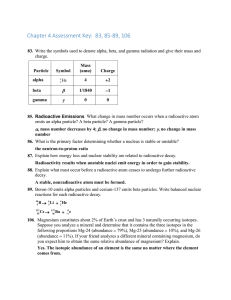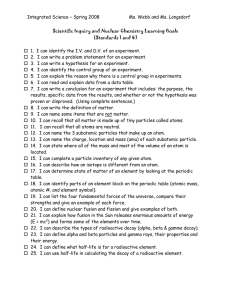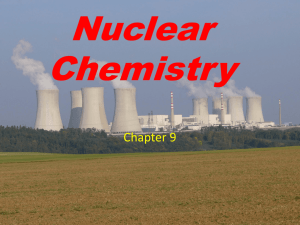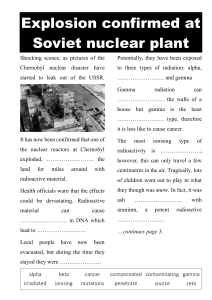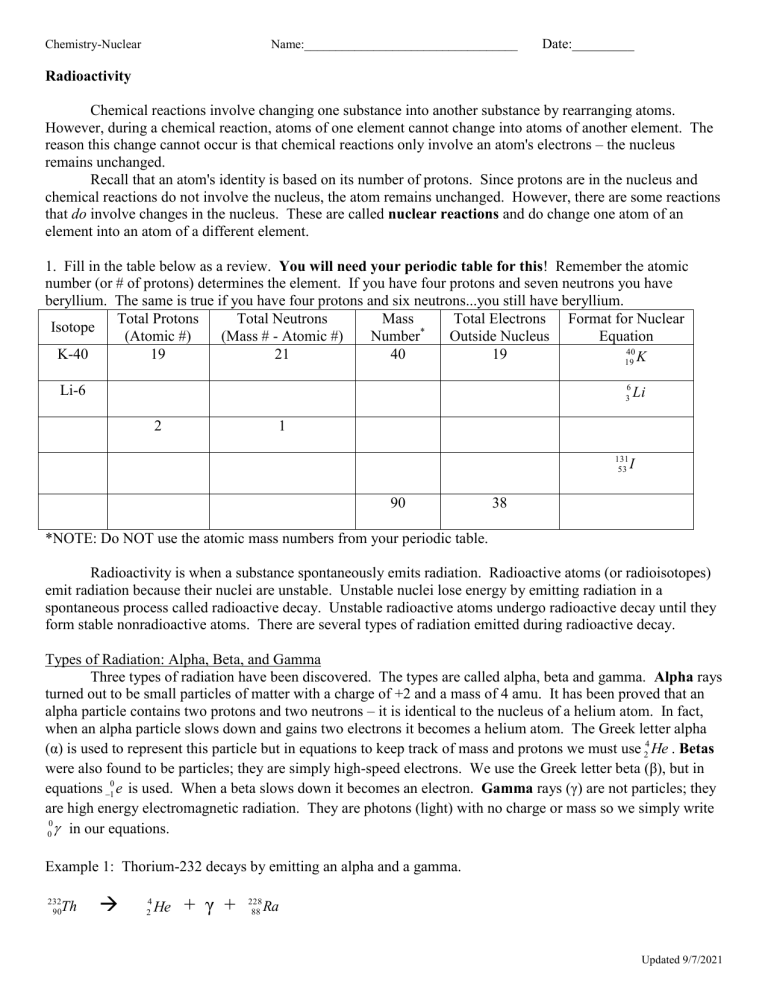
Chemistry-Nuclear Name:__________________________________ Date:_________ Radioactivity Chemical reactions involve changing one substance into another substance by rearranging atoms. However, during a chemical reaction, atoms of one element cannot change into atoms of another element. The reason this change cannot occur is that chemical reactions only involve an atom's electrons – the nucleus remains unchanged. Recall that an atom's identity is based on its number of protons. Since protons are in the nucleus and chemical reactions do not involve the nucleus, the atom remains unchanged. However, there are some reactions that do involve changes in the nucleus. These are called nuclear reactions and do change one atom of an element into an atom of a different element. 1. Fill in the table below as a review. You will need your periodic table for this! Remember the atomic number (or # of protons) determines the element. If you have four protons and seven neutrons you have beryllium. The same is true if you have four protons and six neutrons...you still have beryllium. Total Protons Total Neutrons Mass Total Electrons Format for Nuclear Isotope (Atomic #) (Mass # - Atomic #) Number* Outside Nucleus Equation 40 K-40 19 21 40 19 19 K 6 3 Li-6 2 Li 1 131 53 90 I 38 *NOTE: Do NOT use the atomic mass numbers from your periodic table. Radioactivity is when a substance spontaneously emits radiation. Radioactive atoms (or radioisotopes) emit radiation because their nuclei are unstable. Unstable nuclei lose energy by emitting radiation in a spontaneous process called radioactive decay. Unstable radioactive atoms undergo radioactive decay until they form stable nonradioactive atoms. There are several types of radiation emitted during radioactive decay. Types of Radiation: Alpha, Beta, and Gamma Three types of radiation have been discovered. The types are called alpha, beta and gamma. Alpha rays turned out to be small particles of matter with a charge of +2 and a mass of 4 amu. It has been proved that an alpha particle contains two protons and two neutrons – it is identical to the nucleus of a helium atom. In fact, when an alpha particle slows down and gains two electrons it becomes a helium atom. The Greek letter alpha (α) is used to represent this particle but in equations to keep track of mass and protons we must use 24 He . Betas were also found to be particles; they are simply high-speed electrons. We use the Greek letter beta (β), but in equations 10 e is used. When a beta slows down it becomes an electron. Gamma rays (γ) are not particles; they are high energy electromagnetic radiation. They are photons (light) with no charge or mass so we simply write 0 0 in our equations. Example 1: Thorium-232 decays by emitting an alpha and a gamma. 232 90 Th 4 2 He + γ + 228 88 Ra Updated 9/7/2021 Chemistry-Nuclear Name:__________________________________ Date:_________ Example 2: Uranium-239 decays by emitting a beta and a gamma. 239 92 U 0 1 e + γ + 239 93 Np NOTE: notice that 92 – [-1] = 93; there is always an increase in the atomic number with beta emission. In the above examples you should notice that the sum of the mass numbers on the left of the arrow equals the sum of the mass numbers on the right of the arrow and that the sum of the protons on the left equals the sum of the protons on the right. 2. Complete the following table. Name Charge Mass Greek Symbol Equation Symbol Identity ALPHA BETA GAMMA When an atom undergoes radioactive decay the product nucleus is often unstable and undergoes further decay. This occurs until a stable nucleus is produced. (There is no way for a student to know how an atom will decay. We will always tell you the mode of decay for equations.) 3. Write the nuclear equations for the following radioactive decay series. Use the periodic table. uranium-235 emits an alpha ___________________________________________ thorium-231 emits a beta and a gamma ___________________________________________ protactinium-231 emits an alpha and a gamma ___________________________________________ actinium-227 emits a beta ___________________________________________ Th-227 emits an alpha and a gamma ___________________________________________ Ra-223 emits an alpha ___________________________________________ Rn-219 emits an alpha ___________________________________________ Po-215 emits an alpha and a gamma ___________________________________________ The product from above emits a beta ___________________________________________ The product from above emits an alpha ___________________________________________ The product from above emits a beta and a gamma ___________________________________________ Updated 9/7/2021 Chemistry-Nuclear Name:__________________________________ Date:_________ Bombardment Reactions So far, the equations we have written have involved natural radioactive decay and therefore natural transmutation (changing of one element into another element). However, we have learned to cause transmutation by bombardment of nuclei with high-energy particles. Bombardment allows us to prepare hundreds of isotopes that do not naturally exist, plus this is the method for the production of transuranium elements, all of the man-made elements that follow uranium on the periodic table. Example: Boron-10 is bombarded with a neutron yielding an alpha and another product. 10 5 B + 1 0 n 4 2 He + 7 3 Li HINT: 1 Neutron = 0 n Proton = 1 1 p Write nuclear equations for the following bombardment reactions. a. Platinum-196 is bombarded by a deuteron (H-2), producing platinum-197 and a proton. ___________________________________________________________________________________ b. Nitrogen-14 is bombarded by a neutron, producing carbon-14 and a proton. ___________________________________________________________________________________ c. Plutonium-239 plus an alpha yields three neutrons and a transuranium element. ___________________________________________________________________________________ d. Uranium-238 plus a neutron yields a beta and another product. ___________________________________________________________________________________ Review of Nuclear Equations You are to write out the complete nuclear equations for the following reactions. You will need to determine the identity of the unknown product. ***DON’T FORGET!!! Emission… is a word used to express that something is coming OUT of the nucleus. These should be placed on the RIGHT of the arrow and subtracted from the nucleus. ***DON’T FORGET!!! Bombardment is a word used to express some particle or radioisotope is forced INTO a nucleus. These should be added to the target on the LEFT of the arrow. a. Iodine-131 decays by beta and gamma emission. ___________________________________________________________________________________ b. Polonium-218 decays into lead-214 and another product. ___________________________________________________________________________________ c. Uranium-235 decays by alpha and gamma emission. ___________________________________________________________________________________ d. Nitrogen-14 is bombarded with an alpha, producing a proton and oxygen-17. Updated 9/7/2021 Chemistry-Nuclear Name:__________________________________ Date:_________ Half-life 1. What is a radioactive isotope_____________________________________________________________ 2. What is radioactive decay? ______________________________________________________________ 3. What is half-life? ______________________________________________________________________ 4. If we start with 400 atoms of a radioactive substance, how many would remain after one halflife?_________ after two half-lives? _________ after three half-lives? _________ after four halflives? ________ 5. If we start with 48 atoms of a radioactive substance, how many would remain after one halflife?_________ after two half-lives? _________ after three half-lives? ___________ after four halflives?_______ 6. If we start with 16 grams of a radioactive substance, how much will remain after three half-lives?________ 7. If we start with 120 atoms of a radioactive substance, how many will remain after three half-lives?________ Use the following graph to answer questions 8-11… 8. How long is a half-life for C-14?____________ 9. If only 25% of the carbon-14 remains, how old is the material containing the carbon-14? ________ 11. If a sample known to be about 10,740 years old has 400 carbon-14 atoms, how many atoms were in the sample when the organism died? _________ 12. Which type of nuclear radiation (beta particles, gamma rays, or alpha particles) can be blocked by… a) a piece of paper ____________ b) a sheet of aluminum ____________ c) a piece of lead ____________ Use the following chart to answer questions 13-16… Radioactive Substance Radon-222 Iodine-131 Radium-226 Carbon-14 Plutonium-239 Uranium-238 Approximate half-life 4 days 8 days 1600 years 5730 years 24,120 years 4,470,000,000 13. If we start with 8000 atoms of radium-226, how much would remain after 3,200 years? __________ 14. If we start with 20 atoms of plutonium-239, how many would remain after 48,240 years? __________ 15. If we start with 60 atoms of uranium-238, how many remain after 4,470,000,000 years? _________ 16. If we start with 24 atoms of iodine-131, how many remain after 32 days? ___________ Updated 9/7/2021
